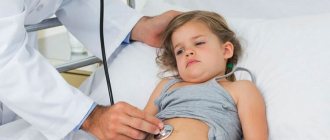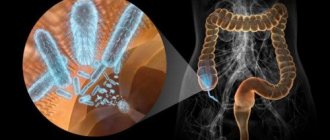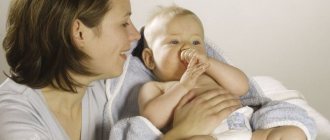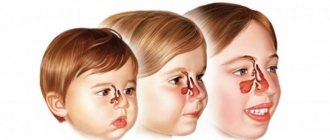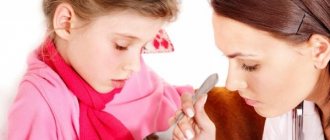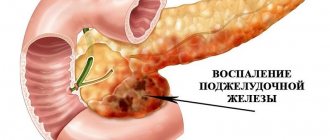A baby is born with a sterile intestinal tract and its colonization with – useful and not so – microflora begins from the moment the baby is born. Ideally, these should be lactobacteria, bifidobacteria and certain types of colibacteria. The latter belong to the group of opportunistic microflora and actively multiplying E. coli in an infant can provoke the development of coli infection.
There are several types of E. coli. Thus, pathogenic microorganisms that should not be in the intestines include hemolyzing Escherichia coli. Even a small amount of it causes severe intestinal upset in a child.
The second variety, lactose-negative Escherichia coli, is included in the category of opportunistic microflora and is present in a certain amount in the gastrointestinal microflora.
Causes
Escherichia coli is the causative agent of acute intestinal infections affecting the gastrointestinal tract. It enters the human body along with dirty water or contaminated food. The greatest danger of contracting an intestinal infection comes from unpasteurized milk, meat, as well as vegetables and fruits contaminated during watering. E. coli is also transmitted through dirty hands.
Pathogenic bacteria are everywhere: in the soil, air, water, grass and on all household objects. The most favorable environment for the proliferation of E. coli is humidity and heat . It is known that if an intestinal infection was detected in a children's institution, it will definitely be closed for quarantine.
In order to detect an infection in a timely manner, you need to know what E. coli is in a child. There are many varieties of E. coli. Some of them are especially pathogenic and manifest themselves most often in the body of very young children. They are able to live in the baby’s intestines without any painful symptoms, manifesting themselves only when the body’s immunity decreases.
Treatment of hemolytic E. coli
The presence of hemolytic bacteria in the gastrointestinal tract of an infant, regardless of their concentration, is already considered a deviation from the norm. Treatment in this situation should begin with taking rehydration solutions and sorbent preparations. These medications allow you to restore the water-salt balance. This is extremely important, since a disease of this type will always be accompanied by intestinal upset.
Then the doctor may prescribe medications containing probiotics, bacteriophages, and bifidobacteria for treatment.
If the child’s condition is serious, and the concentration of hemolytic microflora is quite high, then, according to the doctor’s decision, the baby may be prescribed special antibacterial agents. Antibiotics are prescribed for such diseases extremely rarely and only in exceptional cases.
The famous doctor Komarovsky noted in his writings that an increase in the concentration of E. coli in the gastrointestinal tract of an infant will not always be a pathology that would require specific treatment. He also says that taking antibacterial drugs by children under one year of age in such situations is categorically not justified, since antibiotics in this case destroy all microflora - pathogenic, opportunistic, and beneficial.
How does infection occur?
Pathogenic E. coli is transmitted through contact with an infected person . If all the necessary hygiene rules are not maintained in a child care facility, an intestinal infection becomes an outbreak. This disease primarily affects the small intestine of the child.
As a rule, E. coli appears in children in the summer, since at this time children often walk outside, come into contact with other children, play with cats and dogs, touch them, and then put their fingers in their mouths. If parents have not taught their child the rules of hygiene, no one can protect him from E. coli infection.
Treatment methods
If you suspect infection in children under one year old, you should immediately call an ambulance, since it is possible to help a newborn if his body has been colonized by hemolytic E. coli only in a hospital setting. Pediatricians will definitely take tests - blood, urine, feces and vomit samples.
If a large amount of a pathogenic strain is detected in the baby’s stool, doctors will carry out the necessary therapy, administer intravenous and intramuscular medications, and replenish lost fluids and mineral salts.
Children over one year old can be successfully treated at home according to the following scheme:
- Carry out antibacterial therapy. The best remedy is Nifuroxazide syrup, intended for the treatment of acute intestinal infections. You need to take it for 5-7 days in a dosage according to the instructions for the child’s age.
- Give the child a large amount of liquid (1-1.5 liters per day), prepared from special preparations for oral rehydration - “Regidron”, “Hydrovit”, “Humana Electrolyte”, “Maratonic”, “Gastrolit”, “Orsol”. WHO gives recommendations for preparing a similar solution at home: 1 teaspoon of table salt and soda, 1 tablespoon of sugar per 1 liter of water.
- Cleanse the body of toxins, since E. coli in infants can cause severe intoxication. The most effective sorbents are Enterosgel, Polysorb, Bactistatin, Smecta, Sorbex, Sorbolong. The method of administration and dosage are described in detail in the instructions for the drug.
- Help digest and absorb food. When infected with E. coli, enzyme deficiency often develops, so it is recommended to give the baby enzymes with food to improve digestion - “Mezim”, “Pancreatin”, “Creon”. Many pediatricians consider the latter drug to be the best.
- Restore normal intestinal microflora. Probiotics and prebiotics will help cope with this task. Probiotics are ready-made live microorganisms that normally inhabit the human intestines, and prebiotics are chemical compounds that create favorable microflora for the growth and reproduction of beneficial bacteria. During the first week, it is recommended to give the child probiotics - “Linex”, “Lactobacterin”, “Lactimak”, “Enterol”, “Bifiform”. During the second week, it is advisable to switch to prebiotics - Laktofiltrum, Goodluck, Duphalac, Lizalak, Fervital. By the way, breast milk itself is a unique natural prebiotic that helps restore the intestinal microflora in just 1-2 days, so this point can be skipped when treating breastfed children.
Follow a diet for two weeks so as not to put unnecessary strain on the liver and pancreas: cook porridge and soups in water, avoid fatty foods, limit meat, milk and eggs, exclude raw vegetables, fruits and juices.
With such therapy, even without antibiotics, the child should feel significantly better already on the 3rd day of treatment, and on the 5th day, recovery occurs in 90% of cases. For the next 2 weeks, it is recommended to take care of the body and do everything possible to help restore the immune system.
Signs and symptoms of the disease
Children's intestinal infections that occur during the warm season are called seasonal. There are other types of bacteria that can infect a child’s body at any time of the year. It is the child's body with an undeveloped defense mechanism that most often becomes a victim of pathogenic bacteria.
The first symptoms of E. coli infection begin to appear a few hours after infection. Each infection has its own specific symptoms. Children most often become victims of enterobacteria : shigella, E. coli, plague coli and salmonella. Main symptoms of infection:
- Dehydration of the body.
- Acute cramps in the intestines.
- Nausea and vomiting.
- Diarrhea.
- Infection with shigellosis is accompanied by a sharp increase in body temperature (up to 40 C), convulsions and fever. Thinking disorders may occur. The frequency of stool can reach up to 25 times a day. There is blood (severe form of the disease) and mucus in the stool.
- Escherichiosis in children is accompanied by a sharp decrease in activity, poor appetite and bloody stools. The consequence of this infection is dehydration, a severe decrease in urine volume and sunken eyeballs.
- Salmonellosis has all the symptoms of gastritis, with the only difference being that the stool is usually swamp-colored with impurities of mucus and blood.
Symptoms
After penetration into the child’s gastrointestinal tract, the bacillus begins to actively multiply, which causes an imbalance in the local microflora. Hemolyzing E. coli in infants and newborns causes the development of dysbiosis.
Typical signs of the presence of a pathogen in the gastrointestinal tract of an infant are:
- regular intestinal colic - pain increases significantly after feeding;
- loss of appetite - the child refuses to eat;
- frequent regurgitation - a symptom caused by impaired intestinal motility;
- diarrhea - foamy stool containing mucous inclusions, the smell is putrid and sour;
- weight loss;
- poor general health - the baby does not sleep well, is constantly capricious.
Dehydration poses a particular danger. Signs include: dry skin and mucous surfaces, the appearance of skin folds that do not smooth out, impaired urination - the child pees less than once in 4 hours, crying without secretion of tear fluid.
In older children - from 1-1.5 years - the clinical picture of the infection looks somewhat different. Its initial symptoms resemble the development of gastroenteritis. The child appears:
- pain in the epigastric region of a cramping or aching nature;
- attacks of nausea, sometimes ending in vomiting;
- heaviness in the stomach;
- diarrhea;
- slight increase in body temperature;
- headache, dizziness;
- loss of appetite;
- general weakness, increased fatigue;
- symptoms of dehydration.
In severe cases of the disease, the skin becomes pale until a full blue tint appears. A slowdown in heart rate and a decrease in blood pressure are recorded.
Diagnostics
The presence of blood in liquid stool is a sign of many diseases that are not infectious. To detect the presence of E. coli, tests of stool, blood (for sepsis) and vomit are prescribed. If a child is suspected of having an intestinal infection, the doctor asks the parents for the exact time since the infection, symptoms and factors that could have provoked the infection. It is also important to know if the child has diseases that increase the risk of infection. The doctor will be able to choose the right treatment only after receiving test results.
Treatment
As a rule, when E. coli is detected, supportive treatment . Remember that self-treatment of this disease in children is unacceptable, since the presence of certain types of E. coli can cause death.
Even with a mild intestinal infection in children, treatment should be carried out under the supervision of a doctor. Timely treatment is the key to success for a speedy recovery. The most effective treatment is only possible in a clinical setting.
If you notice the first symptoms of an intestinal disorder in your child, consult a doctor immediately . Before he arrives, you need to skip 1-2 feedings and give the baby more water. This is very important because if you are severely dehydrated, you will need to give fluids intravenously. Symptomatic treatment is aimed at reducing high fever, pain relief and eliminating flatulence. Treatment of intestinal infection consists of using antibiotics and following a diet and regimen:
- Oral intake of drugs rich in glucose and minerals (Regidron and Glucosolan). The solution should be given to the child every 10 minutes throughout the day. To improve absorption, the drug should be warm.
- The course of treatment with antidiarrheal drugs is 2 weeks.
- Antispasmodics (“No-spa”) help relieve sharp pain in the intestinal area.
- Food for a child should be tasty and prepared from quality ingredients.
- The diet depends on the age of the baby.
- You should not force him to eat.
- You should not feed your baby at night.
- In case of a mild form of the disease, in the first days it is necessary to reduce the usual portion of food by about 20%, while adding 2 feedings.
- In case of severe infection, the amount of food should be reduced by 50% and 3 feedings should be added.
- You can increase the amount of food after 5 days.
- In the case of treating an infant, the interval between artificial and breastfeeding should be shortened, and the nutritional intake should be reduced by 1/3.
Treatment of infection
Many factors are taken into account when drawing up a treatment protocol. In particular: the child’s age, severity of the disease, current symptoms, the body’s response to medications.
In order to suppress the activity of the pathogen, antibiotics are prescribed. Medicines from the line of fluoroquinolones (Ciprofloxacin, Gatifloxacin, Levofloxacin), which have a wide spectrum of action and a small number of side effects, are often used. Pathogen addiction syndrome develops slowly.
For mild cases of the disease, oral rehydration is recommended for the child. He should drink as much fluid as possible throughout the day. This helps restore the disturbed water-salt balance, and also compensates for the fluid lost by the body. You can purchase the drugs at any pharmacy. They are available in powder form for preparing an aqueous solution.
In severe cases of the disease, saline solutions are used for intravenous administration. Infusion detoxification is carried out in a hospital setting and is implemented in order to remove toxins accumulated in the body. The child receives a large volume of fluid intravenously (drip). The most commonly used solutions are salts and glucose.
Symptomatic treatment is aimed at improving general well-being. The patient may be prescribed:
- sorbents – drugs that help cleanse the gastrointestinal tract;
- antidiarrheal medications - Immodium, Enterofuril, Loperamide and others;
- antispasmodics - drugs that eliminate pain - No-Shpa, Spazmalgon, Plantex, etc.;
- non-steroidal anti-inflammatory drugs - necessary to eliminate the inflammatory process - Ibuprofen, Indomethacin, Ketoprofen and others;
- eubiotics, probiotics, prebiotics - drugs that restore the imbalance of microflora - Laktovit, Bifidumbacterin, Linex, etc.;
- vitamin complexes.
During the entire period of treatment, the child must adhere to the principles of dietary nutrition and maintain a water regime. In the acute period (with severe diarrhea), table No. 4 is recommended, which involves reducing the intake of fats and carbohydrates, limiting salt, and frequent split meals.
After improvement of the condition and stabilization of the stool, the patient is transferred to diet No. 2. It provides the healing body with all the necessary substances.
Modern medicine has made great strides forward and the presence of hemolyzing E. coli in a child’s body does not pose a significant danger to him. Timely initiation of therapy allows you to get rid of the infection and eliminates the formation of any complications.
Among human pathological conditions, the most dangerous may be diseases caused by Escherichia coli. They lead to severe complications, sometimes lifelong, even death. People with weakened immune systems are predominantly at risk, including infants, pregnant women, and elderly people (over 60 years of age). Treatment of infants is especially stressful, since their body is not yet able to independently repel the attacks of pathogenic microbes. We'll tell you how to deal with E. coli and how to prevent infection.
Course of the disease
The essence of E. coli infection is damage to the intestines. Harmful decay products of pathogenic bacteria disrupt metabolism, causing poisoning, which determines the stage of the disease. The incubation period ranges from 3 to 10 days .
The general condition of a sick child depends on the degree of intoxication. , depression of the central nervous system occurs . The child becomes lethargic, his face is drawn, his eyeballs are sunken, his eyes are sick. Frequent nausea, vomiting and clouded consciousness are also observed. Hands and feet become cold and take on a pale blue hue. If in this case you do not seek medical help, the disease can be fatal.
There are also mild forms of the disease, accompanied by intestinal upset without any pronounced symptoms. If you do not start treatment for your child on time or start it too late, the disease can become chronic, leading to depletion of the body. The course of the disease can lead to complications of the lungs, ENT organs and genitourinary system.
Treatment and prevention
When drawing up a treatment plan for an intestinal infection, many factors are taken into account:
- child's age;
- complexity of the disease;
- symptoms;
- the reaction of a small organism to medications.
It is important to provide the baby with fluids in the body.
You need to treat in several directions:
- Fighting the pathogen. To prevent further development and reproduction of pathogenic bacteria, antibacterial drugs are prescribed. The fluoroquinolone, penicillin or nitrofuran series are most often prescribed.
- Fight dehydration. During the period of fighting infection, the child should consume a lot of fluid (at least 3 liters per day). This will help restore the water-salt balance. To speed up the process, special powdered rehydration preparations are used.
- Fighting intoxication. Drinking a large amount of fluid is also necessary to remove toxins from the body. Infusion detoxification therapy consists of administering saline solutions and glucose intravenously.
- Symptomatic treatment. To speed up the recovery process, they fight all associated symptoms. Complex therapy will consist of the additional administration of sorbents, antidiarrheal and non-steroidal drugs, antispasmodics, and complex vitamins. It is mandatory to take eubiotics (prebiotics and probiotics), which accelerate the restoration of intestinal microflora.
To restore a small body from dehydration, glucose drips are often prescribed.
On a note! Throughout the treatment, the child must adhere to a special diet (diet No. 2), which will provide the small body with all useful and nutrients.
Since the main reason for the development of E. coli is the weakened immunity of the infant, the main preventive protection against infection is breastfeeding. Pediatricians recommend not giving up breastfeeding for up to a year if possible. If breastfeeding is not possible, then formulas containing prebiotics are selected.
It is very important to observe the rules of personal hygiene so that objects of constant use do not become carriers of bacteria. Mothers need to monitor the purity and quality of the foods she eats. If the parent eats infected food, the pathogen will enter the small body along with breast milk.
Breastfeeding helps your baby develop a strong immune system
In the early stages of development, hemolyzing intestinal infection resembles colic symptoms. Parents need to closely monitor the baby’s condition so as not to develop the disease. The earlier the disease is detected, the easier it is to fight it.
Prevention
The main condition for the prevention of E. coli infection in children is strict adherence to hygiene :
- Fight against insects that are carriers of infections (flies, etc.).
- Personal hygiene: washing hands with soap after using the toilet, before eating and after going outside.
- Wash vegetables, berries and fruits.
- Proper food storage.
- Maintain hygiene during cooking: mandatory boiling of milk and careful heat treatment of meat products.
- Thorough washing of dishes.
- Hardening the child.
- Avoiding contact with people infected with E. coli.
After treatment, parents should make sure that the intestinal infection does not lead to dysbacteriosis. If this happens, treatment is necessary to restore the intestinal microflora.
As soon as a baby is born, his body becomes exposed to various microorganisms. They do not cause any trouble for an adult, but an infant’s body is still weak, and the immune system has not yet developed. That is why E. coli is a common occurrence in infants. Parents are scared, but in reality there is no serious reason to panic. You just need to identify the signs in time and prescribe treatment.
Easy educational program
Escherichia coli is a type of bacteria that inhabits primarily the lower intestine of warm-blooded animals and humans (hence the name of the bacterium). Scientists have identified several strains (types) of E. coli, which differ from each other at the molecular level and cause different physiological processes. Interestingly, certain strains can only survive in certain hosts, which makes it possible to determine the source of infection - bird, mammal or human.
Some strains, for example, lactose-negative E. coli in infants, are part of the normal intestinal microflora. They colonize the infant's intestines, which are sterile from birth, within 40 hours, coming from the environment, and remain there for life. Such conditionally pathogenic bacteria are necessary and bring great benefits to the body: they participate in the synthesis of vitamin K and B, nicotinic and folic acids, destroy harmful microbes, promote the digestion and proper absorption of food (for example, the absorption of calcium and iron), and participate in metabolic processes. Some strains (probiotics) are even specifically introduced into the intestines to treat certain diseases. The main thing is that the baby’s E. coli does not rebel and begin to actively multiply and parasitize.
Important! As long as the E. coli indicator does not exceed the norm - 10*5 CFU/g, which occupies only 1% of all microorganisms in the intestines, there is no reason to worry, since the bacteria are doing useful things: they produce vitamins that the body needs, acids, ensure the vital activity of bifidobacteria, and promote normal digestion of food, limit the growth of pathogenic microorganisms.
Is it dangerous
You shouldn't always be afraid of such a problem. To understand whether you should worry, you need to know the digestive process. It is different for a child. At first, the intestinal microflora of the baby is clean and sterile, since the first feeding has not yet occurred. There are no foreign bacteria. Microorganisms begin to emerge only on the 2-3rd day.
These bacteria are not dangerous. On the contrary, they help break down food debris and form feces. The baby begins to go to the toilet: he does this up to 4 times a day. This is all normal, so there is no cause for concern.
The first microorganisms begin to contribute to the functioning of all organs. For example, they improve blood circulation and improve breathing. The child's heart rate increases. The blood is filled with oxygen, which is so necessary for many life processes.
But there are situations when you should be wary because problems arise. Sometimes pathogenic bacteria begin other activities. Dysentery and salmonellosis occur - frequent intestinal infections in infants.
How to recognize
Usually in infants the infection enters in a common way through the mouth. Since babies love to put small foreign objects into their mouths, microbes also enter the digestive system. But you shouldn’t scold your child for this. The process is natural, in this way the baby learns about the world around him.
The infection also spreads through unwashed hands and untreated dishes. If the pacifier fell on the floor, and the parents did not wash it, but immediately gave it to the baby, microorganisms will not keep you waiting . Much depends on the carelessness of parents: a large percentage of diseases and intestinal problems occur for this reason. It is important to be able to recognize the first signs of infection. It is easy to distinguish them, since the child’s body reacts very sharply to infections. Here are the main signs that should alert any parent:
- temperature. Infection is inflammation, and the body fights it in a standard way by raising body temperature. High temperature is an alarming signal. The baby's arms and legs turn red, he becomes lethargic;
- loose stools also indicate that there are problems with the intestines. In this case, it is clearly clear that there is an infection in the stomach and intestines;
- regurgitation;
- behavior. Babies with infection cry, scream, and refuse to sleep or eat. This sign should alert you, since the behavior directly indicates problems in the body;
- Mom can feel the tummy. If at the same time she felt something solid or felt liquid, it means that not everything is in order with digestion.
How to get rid
At the first sign of intestinal problems, parents should seek medical help. You cannot self-medicate: what will help an adult will not help a child. Only a doctor can identify the infection and select treatment. The baby can be left at home or sent to the hospital with the mother.
Usually the doctor prescribes special medications, for example, Smecta. This is a soft sorbent that effectively copes with infection. Toxic substances are quickly and naturally eliminated from the baby’s body. “Smecta” not only gets rid of bacteria, but also restores the natural balance in the intestinal microflora.
But what you definitely shouldn’t give to a baby is antibiotics. Therefore, you should not self-medicate with antibiotics.
Many medications eliminate diarrhea but do not fight the infection. “Smecta” acts differently: it forms a protective mucous membrane that protects against bacteria, germs, and gases. Now they are not scary for the child, so parents don’t have to worry.
The drug powder is dissolved in water. Give it to the baby in a bottle, dissolving one sachet there. The course of treatment is 3 days. Usually during this time all symptoms disappear. But if this does not happen, you should choose another treatment. But everything is done only under the supervision of a doctor.
If the baby is given any other medications, Smecta should be given only after two hours. Otherwise, the drug adsorbs medications.
If the doctor insists on hospitalization, it is better to do this, since an infection in an infant is dangerous. Diarrhea and vomiting dehydrate a weak child's body. It is almost impossible to restore moisture, and this can even be fatal.
The baby will be under constant supervision in the hospital. Here they will immediately collect tests to identify the pathogen. Since test results will not be available immediately, and help is needed immediately, the baby may be placed on a glucose drip. This is necessary because the fluid needs to be restored and the temperature reduced.
In the hospital, infants are given antiemetic and antipyretic drugs. A day later, some tests are ready. But some results are ready only on the third day or even on the fifth.
Symptoms of infection in infants
With the development of Escherichia coli, the child’s condition sharply worsens
The development of Escherichia coli in large quantities becomes the main cause of imbalance of the microflora of the gastrointestinal tract in newborns. The child becomes restless, sleep is disturbed, and abdominal pain appears, usually after feeding. Symptoms are varied:
- Bloating, rumbling and increased gas production,
- The appearance of vomiting
- After feeding, regurgitation occurs more often than usual,
- A kind of diarrhea. Foamy stool is accompanied by an unpleasant sour odor,
- In case of serious illness, the child may lose weight.
You should also monitor the general physiological condition of the baby. Increased drowsiness, weakness, increased body temperature or infrequent urination are the first signs of problems with the gastrointestinal tract.
Common Germs
Hemolyzing Escherichia coli. Often occurs in small infants. Symptoms: bloating, gas. The child experiences constipation and green streaks in the stool. However, the hemolyzing bacillus is not characterized by a high temperature, so it is difficult to notice.
Hemolyzing bacillus is treated with diet. But in a baby everything happens differently, so it’s better to consult a doctor. He will advise and prescribe treatment. The hemolyzing rod should not be present in the body at all.
There is also lactose-negative E. coli. It is included in the list of opportunistic microbes. The lactose-negative bacillus is present in the child’s body and is responsible for the production of vitamins K and B, takes part in metabolic processes, helps absorb calcium and other substances.
But if the amount of this bacteria is exceeded, problems arise: the child suffers from frequent gas formation, regurgitation, constipation, diarrhea, and pain. Therapy includes treatment with bifidobacteria and probiotics. But everything is individual, depending on the condition and age of the child. First, tests are carried out, and only then the doctor prescribes treatment.
Conclusion
Hemolyzing E. coli in infants is a fairly common phenomenon, but only through diagnostics can the pathology be identified and the correct therapy prescribed. Often mothers confuse the disease with colic, which has similar symptoms. But when a baby develops diathesis, diarrhea, or, conversely, constipation, it is worth thinking about the fact that this may be a consequence of another pathology.
Breast milk from the mother is of great importance in the treatment of infants; she must adhere to a certain diet, as well as adherence to the drinking regime. Diarrhea in a baby can cause dehydration, which can have negative consequences for the little body. It is important to closely monitor the child’s condition in order to notice disturbances in the functioning of the gastrointestinal tract in time.
Prevention
Many infections can be avoided if you follow the rules.
- Strengthening immune defense is the first requirement. Therefore, pediatricians strongly do not recommend stopping breastfeeding before one year. This will protect the baby from infections and future diseases.
- Hygiene. This applies not only to the child himself, but also to other family members. Dishes, clothes, baby diapers - everything should be clean. Even a fallen pacifier should first be washed with boiling water and disinfected, and only then given to the baby.
- If your baby has the first symptoms of the disease, you should immediately consult a doctor. Self-medication is not recommended.
- The mother herself should stick to the diet. You need to eat only healthy foods, more cereals, fruits, vegetables, wholemeal bread. But sweets and baked goods should be limited. Vegetables and fruits must be washed thoroughly and with boiling water. This is especially true in the summer, when the risk of contracting an infection arises.
Escherichia coli is one of the causative agents of intestinal infections. As a result of infection with this type of bacteria, a person develops acute diarrhea, which is accompanied by very severe paroxysmal pain.
Escherichia coli is a very small bacterium whose name was given for a reason. It really looks like a stick with rounded ends. Doctors know almost everything about it. And its main advantage for scientists is its rapid reproduction.
Some types of E. coli are permanent residents of our body. Living in the intestines, they protect the body from the proliferation of pathogenic microflora. In addition, some types of beneficial E. coli are capable of producing vitamin B12 in the body.
Harmful sticks enter the human body with contaminated water and contaminated food. The leaders in the content of E. coli are animal products: milk, beef, etc. Fruits and vegetables can become contaminated when watered or treated with animal fertilizers.
Infection with E. coli can occur through dirty hands if a person does not follow hygiene rules.
Because everyone knows that if this infection is discovered in a kindergarten or at home, the kindergarten will be quarantined and all relatives will be checked. In order to suspect and detect this disease in time, you need to know what E. coli is in children: symptoms and treatment.
Advice from experienced pediatricians
- The first symptoms of E. coli in a baby - diarrhea, vomiting (regurgitation), fever, crying of the child, tucking in his legs - should be a signal to call a doctor.
- The first priority is to stop the diarrhea. Start feeding your child immediately after the second diarrhea.
- Pay great attention to personal hygiene, as well as the child, household items and premises.
- Take care of the health of your newborn, as strong immunity will defeat pathogenic E. coli even without external help.
The most important thing when treating E. coli is to prevent dehydration.
You might be interested in:
Symptoms of dysbiosis in breastfed infants
This is interesting: Medicines that support intestinal microflora when taking antibiotics
Symptoms and signs of E. coli
Like any intestinal infection, the bacillus begins to manifest itself acutely:
- watery stools appear, sometimes with blood;
- rarely a febrile state may develop with a temperature rise of up to 39 degrees;
- signs of intoxication of the body appear;
- green vomit;
- loss of appetite;
- with a long course of the disease, the development of hypovitaminosis is possible.
Diagnosis
Since bloody diarrhea is a symptom of many other non-infectious diseases, it is imperative to separate out the presence of E. coli. To do this, it is necessary to perform a stool analysis, in which specialists will conduct a study for the presence of Shiga toxins.
Patients are also recommended to donate blood to determine the absence of sepsis.
Variants of symptoms
There are no clinical symptoms characteristic only of hemolytic Escherichia coli. The priority role of this particular microbial agent as the main cause of the disease can only be confirmed as a result of laboratory examination.
All variants of clinical symptoms can be somewhat roughly divided into local and general.
General manifestations
They are noted only with a pronounced decrease in immunological resistance. Noted:
- increase in body temperature to low values (usually no higher than 38 ° C);
- weakness, increased fatigue;
- decreased performance, excessive unmotivated drowsiness.
Local manifestations
Just like systemic changes, they are characterized by nonspecificity and polymorphism. It is convenient to consider possible clinical signs in accordance with the predominant localization of the bacterium.
| Localization of the bacterium | Local symptoms |
| Gastrointestinal tract |
|
| urinary system |
|
| Reproductive sphere |
|
Only a doctor can assess the severity of all signs, confirm the etiology of the pathological process and assess the need to eliminate hemolyzing E. coli.
Features of the course of the disease caused by this microorganism are usually not observed in children. It should be noted that in children under 3 years of age, complications develop in a shorter period of time: hypovolemic or infectious-toxic shock.
What are probiotics, names of drugs and their types
